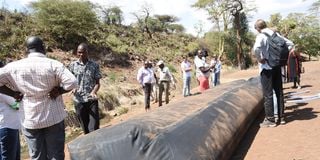Isiolo farmers trained on floods management

A 'slam dam' filled with water from Isiolo River during a demonstration exercise by Zephyr consulting at Kisima area on October 19, 2022. The Dutch technology helps manage flood water minimizing destruction of farms and properties.
Farmers in Isiolo who have had to contend with destruction of their crops by floods and subsequent losses have benefited from a mobile dam technology training for flood and storm water management.
The Dutch technology popularly known as “Slam dam” that is being piloted in Kenya comprises of flexible rubber tubes that tap flood water and create barriers to farms and premises, minimizing damages.
The training targeting farmers within flood-prone areas including along Ewaso Nyiro and Isiolo rivers was done by Zephyr Consulting in partnership with Netherlands Development Organisation (SNV).
Flooding in the region is caused by heavy rains in neighbouring Meru County that result in swelling of the rivers, destroying crops, properties and displacing locals from their homes.
The tubes are filled with water to form sausage-like dams whose sections can be joined and extended like a ‘snake’ to cover a number of kilometres depending on the area the farmer wants to protect.
Tens of farmers were earlier this week taught how to develop the portable dams with water drawn from Isiolo River to inter-locking the units and spreading them to cover a wider area after attending a workshop in Kisimani.

Zephyr Consulting official Lilian Kalela demonstrates to farmers how to set up a "slam dam" at Kisima along Isiolo River on October 19, 2022. The Dutch technology helps manage flood water minimizing destruction of farms and properties.
Zephyr Consulting Project Manager Lilian Kalela said after floods subside, the stored water could be used for drip irrigation and kitchen gardens, thereby mitigating the effects of drought.
“The barrier helps protect agricultural land from flooding and destruction of crops, allowing farmers to maximize their output and be resilient to climate changes,” Ms Kalela told journalists.
Ms Kalela said the dams should be developed when there is an imminent danger of flooding which farmers will know through early warning systems and weather forecasts.
The farmers hailed the technology as the effective solution in mitigating flood risks and enhancing resilience to climate change.
Ms Hellen Murungi, whose maize farm along Isiolo River was affected by flooding, said if equipped with the technology, the farmers would increase the acreage under cultivation for increased productivity.
“We are grateful for the training even though we do not have money to buy the equipment. We appeal to the county government and donors to help us so that we increase productivity and beat hunger,” Ms Murungi, who is Isiolo Water Resource Users organization treasurer, said.
Her sentiments were echoed by David Mwiti Nabea, a farmer, who said the county government should adopt the technology to manage floods in Isiolo town.

Farmers pump water from Isiolo River into a rubber tube to develop a 'slam dam' during a demonstration by a team from Zephyr Consulting on October 19, 2022. The Dutch technology helps manage flood water minimizing destruction of farms and properties.
“We have been rationing water (for farming) due to reducing water levels caused by the prolonged drought resulting in reduced yields. Storing the flood water would assist in enhancing food security,” he noted.
One “Slam dam” costs €1,350 for a five metre section weighing 30 kilograms which can be folded into a box that two people carry.
Unlike traditionally used sand bags that take longer to set up manually, the dams are easy to build as long as one has a high-capacity water pump powered by a generator.
Ms Kalela said they were in initial talks with the Kenyan government and devolved units on how the technology would be rolled out in the country.
“We are engaging several partners on how to roll out the technology in Kenya to assist communities affected by floods and drought,” she said, adding that Isiolo was picked for piloting because it experiences both drought and floods.
SNV official James Mwangi reiterated the organisation’s commitment to improving institutional capacities for climate resilience, promoting good agricultural and efficient water practices for increased production and income.
“The technology will go a long way in poverty reduction through increased farm productivity,” he said.
Nigeria and Burundi are the only countries in Africa implementing the technology.





